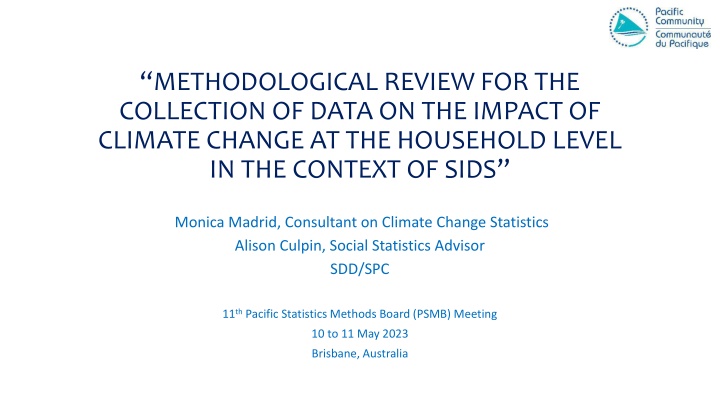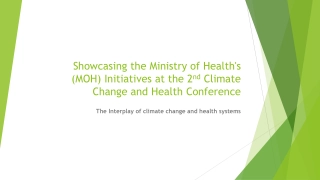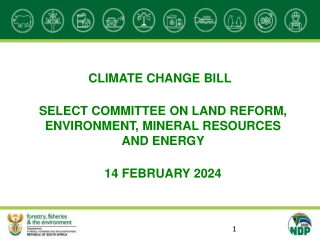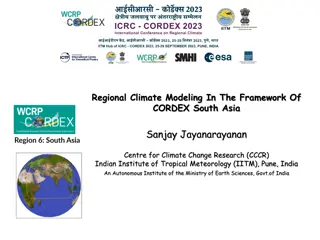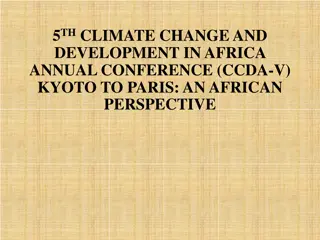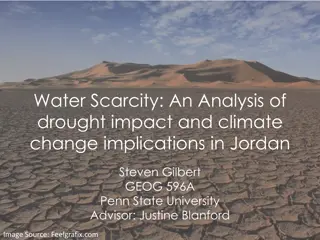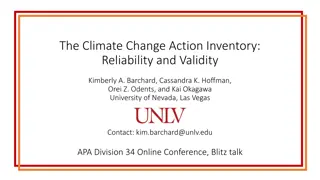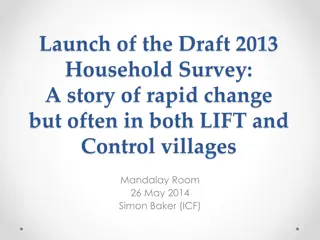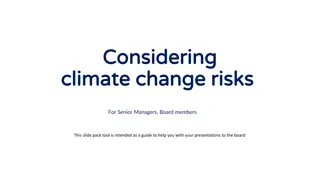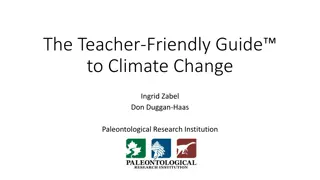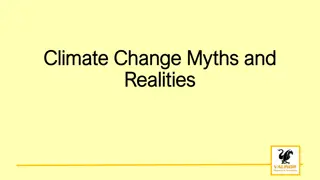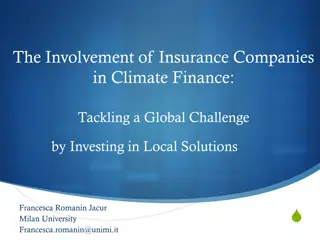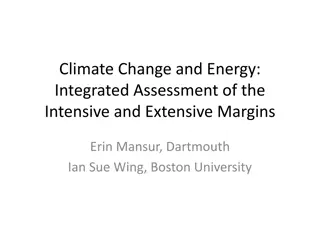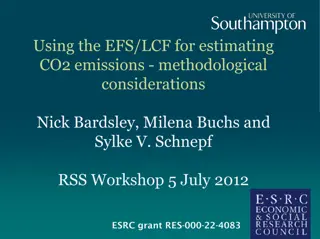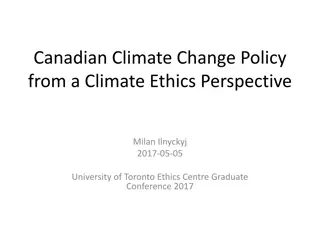Methodological Review for Data Collection on Climate Change Impact at Household Level
This review focuses on methodology for collecting data on climate change impact at household level in Small Island Developing States (SIDS). It covers core module characteristics, sourcebook guidelines, and sampling strategies for effective data gathering.
Download Presentation

Please find below an Image/Link to download the presentation.
The content on the website is provided AS IS for your information and personal use only. It may not be sold, licensed, or shared on other websites without obtaining consent from the author.If you encounter any issues during the download, it is possible that the publisher has removed the file from their server.
You are allowed to download the files provided on this website for personal or commercial use, subject to the condition that they are used lawfully. All files are the property of their respective owners.
The content on the website is provided AS IS for your information and personal use only. It may not be sold, licensed, or shared on other websites without obtaining consent from the author.
E N D
Presentation Transcript
METHODOLOGICAL REVIEW FOR THE COLLECTION OF DATA ON THE IMPACT OF CLIMATE CHANGE AT THE HOUSEHOLD LEVEL IN THE CONTEXT OF SIDS Monica Madrid, Consultant on Climate Change Statistics Alison Culpin, Social Statistics Advisor SDD/SPC 11thPacific Statistics Methods Board (PSMB) Meeting 10 to 11 May 2023 Brisbane, Australia
Agenda Agenda I. The Natural Disasters and Climate Change Sourcebook: a) Core module characteristics. b) Sourcebook characteristics. c) Sections/topics. d) Manual s progress II. Policy Brief Outline.
I. The Natural I. The Natural Disasters and Disasters and Climate Change Climate Change Sourcebook Sourcebook
a. Core module characteristics a. Core module characteristics The Natural Disasters and Climate Change survey module comprises the Core Module and the accompanying Sourcebook. The core module's general objective is to gather nationally relevant and internationally comparable socio-economic data over time, through a short set of fixed questions to be regularly included in existing household surveys and censuses.
a. Core module characteristics a. Core module characteristics
b. Sourcebook characteristics b. Sourcebook characteristics Covers other dimensions The Sourcebook will guide the collection of the impact and response to climate change at the household level, considering multiple dimensions, beyond the ones included in the core module. Different level of detail Short modules or stand-alone survey It will be accompanied by the corresponding The Sourcebook can be used as a source of additional questions for country-tailored short modules, or a stand-alone independent survey. guidelines
b. Sourcebook characteristics b. Sourcebook characteristics Periodicity and recall period Unit of analysis Primary respondent Sampling Depends on the HH surveys sampling strategy in each country. A person that can speak on behalf of all household members or the household as a singular unit. Depends on the HH surveys calendar in each country. We suggest a sample representative at the national, regional and urban/rural levels. Household and individuals. Every three five years could be a recommended periodicity for a stand-alone type survey. Example of Bangladesh: National coverage of the 12 main natural disaster-prone areas. Example of Nepal: National coverage, disaggregating information in the country's urban/rural and main ecological belts. Should be an adult household member knowledgeable about the household's composition and that has lived for at least five years in the locality. Recall period: the past 12 months. IMPORTANT: field testing.
c. Sections/topics c. Sections/topics 0. Interview cover 4A. Agriculture module 4B. Fisheries module 1. Household roster 2. Housing conditions 5. Adaptation to Climate Change 3. Climate change perceptions 4. Impact of natural disasters and climate-induced events at household-level
1. Household roster 1. Household roster Questions for the HH members: Questions for the respondent: 13. What is the sex of [NAME]? 1. What is the sex of [NAME]? 2. What is [NAME]'s relationship to the head of household? 14. How old is [NAME]? 3. How old is [NAME]? 15. (In the case of women) Is [NAME] pregnant? 4. 'What is [NAME]'s present marital status? 16. What is the highest educational level [NAME] has 5. What is the highest educational level [NAME] has completed? completed? 6. Which of the following activity generates most of the income/livelihoods of 17. Does [NAME] have difficulty(ies): the household? 18. Does this household member have access to the 7. The land that you operate for agricultural purposes is: Internet through a mobile phone? 8. What is the total area occupied by your dwelling and any productive or idle land? 9. Where do you go fishing? 10. Are the vessels and other fishing assets: 11. Please provide an estimation of your household's annual income level: 12. Please estimate the value of your household's assets (house, infrastructure, machinery, land, etc.
2. Housing 2. Housing 1. Dwelling ownership 2. Construction material for the outside walls of the dwelling/roof 3. Dwelling location (hazard-prone areas) 4. Distance of the household to the main paved road/port 5. Dwelling proximity to ecosystems 6. Primary source of electricity/hours scheduled energy/outages-blackouts 7. Main source of drinking water/water scarcity 8. Primary type of toilet facility 9. Energy source for cooking 10.Internet conection/how stable it is? 11.Early Warning Information on disasters access
3. Climate change 3. Climate change perceptions perceptions 1. HH knowledge about climate change (definition and causes). 2. HH feelings of concern about climate change and its impacts. 3. Ecosystems HH use for livelihood threatened by climate change. 4. Climate Change threat perception in the present and the future. 5. Types of feelings when hearing or learning about future climate change impacts. 6. Primary sources of information about climate change. 7. HH perception on provincial/national government's actions to counter the impact of climate change and communication on climate change.
4. Impacts of natural disasters 4. Impacts of natural disasters 1. Type of natural disaster impacting the household in the past 12 months; 7. Essential services disrupted and the number of days; 2. Estimated economic value of the damages inflicted to the HH dwelling, agricultural area, farm assets, fishery assets and other productive assets; 8. Displacement: number of HH members displaced; 9. Gender-disaggregated question: consequences individuals suffered; 3. Health Impacts: people dead, missing, injured or sick; 10. Means to receive early information; 4. Impact on access to main roads; 11. Mechanisms used by the HH to reduce the damage during natural disasters; 5. Employment: household members that permanently lost their jobs, household members whose jobs were temporarily disrupted, workdays household members lose; 12. actions taken by the HH to recover after the natural disaster; 6. School attendance: children in the HH not attending school and days of school children in the HH lose; 13. Complementary displacement questions.
4. Impacts of Slow 4. Impacts of Slow- -Onset Climatic Events (SOE) Onset Climatic Events (SOE) 1. Type of SOE affecting the locality in the past 12 months; 2. Manner how SOE events affected the livelihoods of HH; 3. Manner how SOE events affected the health of HH members; 4. Number HH members pushed to displace temporarily or permanently because of SOE events; 5. Manner how SOE events affected the social, cultural and communitarian activities of the HH. SOE events evolve gradually from incremental changes occurring over many years or from an increased frequency or intensity of recurring events.
4A. Fisheries module, including 4A. Fisheries module, including aquaculture and fisheries module aquaculture and fisheries module 1. Household practicing agriculture, livestock, aquaculture, fisheries and forestry during the past 12 months; 2. Type of crops, animals, fish species (or others), forest products produced/caught. 3. Main reasons for crops, animals, production, and catch level losses. 4. Market prices and economic vales of the losses.
5. 5. Adaptation Adaptation to to Climate Climate Change Change 1. Retreat adaptation options adopted by HH for responding to the threats of natural disasters and climate change (e.g. relocation); 2. Defensive adaptation options HH implemented for responding to the effects of natural disasters and climate change (e.g. housing, productive activities, protecting water). 3. Defensive adaptation options governments implemented for responding to the effects of natural disasters and climate change (e.g. responding to coastal fringe/inland flooding, flooding to public infrastructure, natural systems, protecting water). II. Policy brief II. Policy brief Outline Outline 4. Co-existing adaptation options HH/governments implemented for responding to natural disasters and climate change effects (e.g., educational campaigns, elaboration of evacuation plans, crop and energy supply diversification, desalinization systems...). 5. Institutional support (type of support and organizations providing support). 6. HH involvement in climate change adaptation groups, 7. Leading personal challenges limiting individuals action on natural disaster prevention and climate change response.
d. Manual d. Manual s progress s progress
II. Policy brief II. Policy brief Outline Outline
II. Policy brief II. Policy brief Outline Outline
Thank you Thank you alisonc@spc.int monicamadrida@gmail.com
